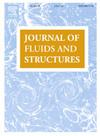开孔率和开孔位置对大跨度桁架屋面结构风荷载及气动稳定性的影响
IF 3.4
2区 工程技术
Q1 ENGINEERING, MECHANICAL
引用次数: 0
摘要
大跨度桁架屋顶结构由于其固有的轻量、小刚度和高灵活性的特性,对风荷载非常敏感。本文研究了大跨度桁架屋盖结构在封闭状态和不同开放状态下的风振响应。这将通过利用压力测量、风洞试验、有限元建模和动态响应分析来实现。本研究统计分析了开孔率和开孔位置对风荷载特性和风响应的影响。采用Welch法和Frequency法研究了脉动风压的频谱特征和低频范围内风压的空间相关演变。研究结果表明,引入通风口可显著降低平均风荷载。然而,这些开口的存在,由于产生了突出的湍流,导致局部风压波动增加。其次,打开过程中产生的摩擦主要耗散低频大尺度涡能,从而导致脉动风压谱的高频分布。在此前提下,对顶板结构的时均风响应、脉动风响应、动力响应谱特征和概率密度分布特征进行了统计分析。结果表明:顶板结构风振响应的变化与风荷载的波动一致,是开孔率的函数。当频率低于主导频率时,开窗通风可减轻结构的风振响应;反之,开窗通风将放大结构的风振响应。大跨度桁架屋面结构的迎风区发生抖振。由于非高斯、非自激气动力和模态振动的存在,结构在屋顶和尾迹区域都发生了气动失稳。本文章由计算机程序翻译,如有差异,请以英文原文为准。
Influence of opening rate and opening position on wind load and aerodynamic stability of long-span truss roof structure
Long-span truss roof structures are significantly susceptible to wind loads due to their inherent properties of being lightweight, small stiffness, and exhibiting high flexibility. The objective of this study is to evaluate the wind-induced response of a long-span truss roof structure under both closed and different open working states. This will be achieved through the utilization of pressure measurement wind-tunnel tests, finite element modelling, and dynamic response analysis. The present study conducts a statistical analysis on the influence of opening rate and opening position on wind load characteristics and wind response. The Welch method and Frequency method are employed to investigate the spectral characteristics of fluctuating wind pressure and the spatial correlation evolution of wind pressure in the low-frequency range. The findings indicate that the introduction of ventilation openings leads to a notable reduction in mean wind load. The presence of these openings, however, leads to an increase in localized wind pressure fluctuations due to the generated prominent turbulence. Secondly, the friction generated during the opening process primarily dissipates low-frequency large-scale vortex energy, thereby leading to a higher frequency distribution of fluctuating wind pressure spectrum. The time-averaged wind response, fluctuating wind response, dynamic response spectrum characteristics, and probability density distribution characteristics of the roof structure are statistically analyzed based on this premise. The results indicate that the variation in wind-induced response of the roof structure aligns with the fluctuation in wind load as a function of opening rate. When the frequency is lower than the dominant frequency, opening ventilation mitigates wind-induced vibration response of the structure; conversely, opening ventilation will amplify wind-induced vibration response of the structure. The windward area of the long-span truss roof structure experiences buffeting. The structural aerodynamic instability occurs in both the rooftop and wake region due to the presence of non-Gaussian, non-self-excited aerodynamic forces and modal vibrations.
求助全文
通过发布文献求助,成功后即可免费获取论文全文。
去求助
来源期刊

Journal of Fluids and Structures
工程技术-工程:机械
CiteScore
6.90
自引率
8.30%
发文量
173
审稿时长
65 days
期刊介绍:
The Journal of Fluids and Structures serves as a focal point and a forum for the exchange of ideas, for the many kinds of specialists and practitioners concerned with fluid–structure interactions and the dynamics of systems related thereto, in any field. One of its aims is to foster the cross–fertilization of ideas, methods and techniques in the various disciplines involved.
The journal publishes papers that present original and significant contributions on all aspects of the mechanical interactions between fluids and solids, regardless of scale.
 求助内容:
求助内容: 应助结果提醒方式:
应助结果提醒方式:


